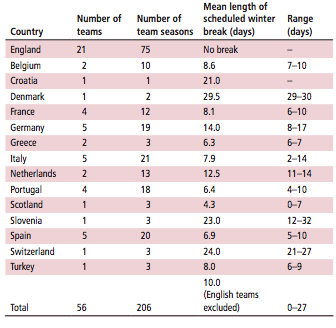Elite football teams that do not have a winter break lose on average 303 player-days more per season to injuries than those teams that do: a comparison among 35 professional European teams

Jan Ekstrand, Armin Spreco, Michael Davison
Objective
To compare injury rates among professional men’s football teams that have a winter break in their league season schedule with corresponding rates in teams that do not.
Methods
56 football teams from 15 European countries were prospectively followed for seven seasons (2010/2011–2016/2017)—a total of 155 team-seasons. Individual training, match exposure and time-loss injuries were registered. Four different injury rates were analysed over four periods within the season, and linear regression was performed on team-level data to analyse the effect of winter break on each of the injury rates. Crude analyses and analyses adjusted for climatic region were performed.
Results
9660 injuries were reported during 1 447 011 exposure hours. English teams had no winter break scheduled in the season calendar: the other European teams had a mean winter break scheduled for 10.0 days. Teams without a winter break lost on average 303 days more per season due to injuries than teams with a winter break during the whole season (p<0.001). The results were similar across the three periods August–December (p=0.013), January–March (p<0.001) and April–May (p=0.050). Teams without a winter break also had a higher incidence of severe injuries than teams with a winter break during the whole season (2.1 severe injuries more per season for teams without a winter break, p=0.002), as well as during the period January– March (p=0.003). A winter break was not associated with higher team training attendance or team match availability. Climatic region was also associated with injury rates.
Conclusions
The absence of a scheduled winter break was associated with a higher injury burden, both before and during the two periods following the time that many European teams take a winter break. Teams without a winter break (English clubs) had a higher incidence of severe injuries following the time of the year that other teams (other European clubs) had their scheduled break.
